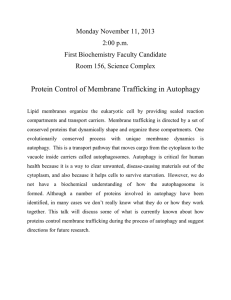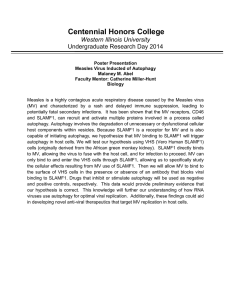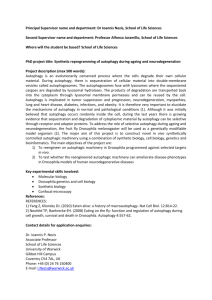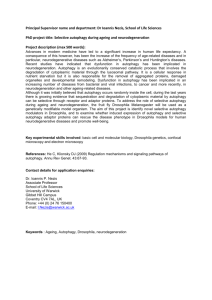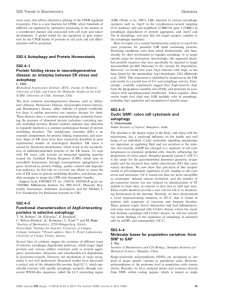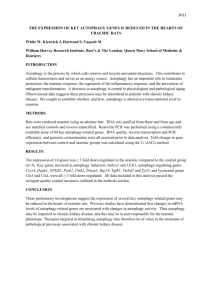Autophagy in filamentous fungi 老師:楊煦星 學生:周政勛 莊詠翔
advertisement
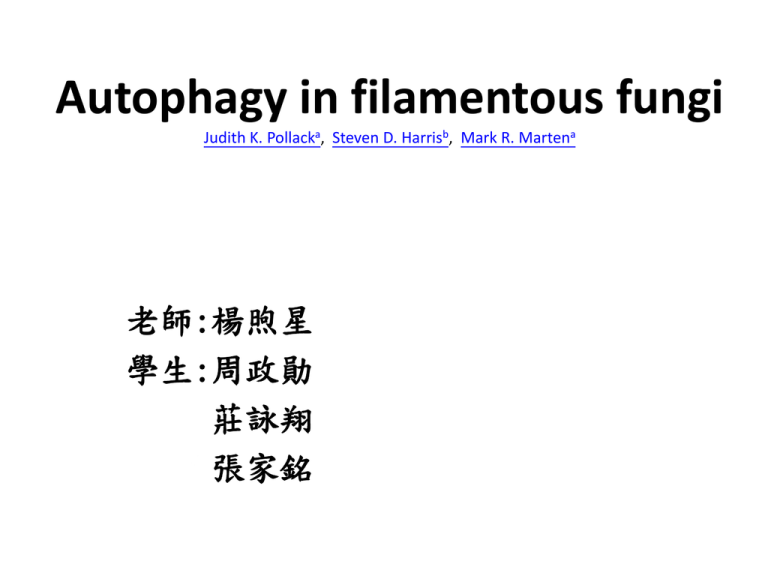
Autophagy in filamentous fungi Judith K. Pollacka, Steven D. Harrisb, Mark R. Martena 老師:楊煦星 學生:周政勛 莊詠翔 張家銘 Abstract Non-selective degradation process in eukaryotic cells. Research has increased significantly in the last ten years. cancer neurodegenerative disease human developmental processes Important role in filamentous fungi. growth , morhology development An autophagy model yeast is Saccharomyces cerevisiae. Characterized by the presence of autophagosomes and controlled by Tor kinase. Fungal autophagy is apparently involved protection against cell death cellular growth and development. Introduction Filamentous fungi play important roles health care agriculture food production bioprocessing In many of these roles,either by default (in nature) or by design (industrial fermentations),fungi experience nutrient starvation. Starvation can lead cellular degradation autolysis apoptosis cell death Fungi also possess a nutrient recycling pathway called autophagy that may prolong cellular survival. Autophagy catabolic processes involving the lysosomal/vacuolar pathway ‘‘the new apoptosis” Connections have even been discovered linking autophagy cancer neurodegenerative diseases human developmental processes The term autophagy can describe a number of cellular phenomena. Macroautophagy Microautophagy Pexophagy Chaperone mediated autophagy Macroautophagy • 極端狀態如饑餓,粒腺體、內質網等大胞器被膜系 吞食進而與溶酶體融合而分解。 Microautophagy • 細胞正常代謝狀態,部份細胞質經膜系包圍,進而 與溶酶體融合而分解。 Pexophagy • 是指過氧化酶體選擇性的自噬作用 Chaperone mediated autophagy • Degradation of specific cytosolic proteins with assistance from chaperone molecules. • 這種類型自噬作用的特點是不使用額外囊泡 Current literature often uses the term ‘‘autophagy” to refer to macroautophagy, the non-specific form of this cellular recycling pathway. Fig. 1. Number of publications on autophagy in various model organisms/groups through December 31, 2007. Search performed on PubMed database using keywords ‘‘autophagy” AND name of organism/group as listed above, limited to the title/abstract to prevent false positives. Overview of autophagy Induction and inhibition of autophagy • As in other organisms, fungal autophagy is typically induced by nutrient (e.g., carbon, nitrogen) starvation . • 當培養環境中具有200 and 500 ng/ml 的 macrolide rapamycin (大環內酯類雷帕黴素), 真菌自噬作用會被誘導。 • 在液態培養時,若rapamycin的濃度明顯高 於60 μg/ml,真菌會被抑制,尤其是對一些 曲霉。 Induction and inhibition of autophagy • 化學或破壞自噬蛋白基因編碼可達到抑制自噬 的作用。 • Chemically e.g 磷脂酰肌醇3-激酶(哺乳動物),3-甲基腺嘌 呤(3-MA)(植物)和渥曼青黴素(真菌)。 ( Inoue et al., 2006) • The disruption of genes coding for autophagy proteins e.g 基因編碼ATG1和ATG8同源的破壞導致類似 生長和分化的表型改變。( Pinan-Lucarré et al., 2003) Autophagy in nutrient recycling • When a colony of the autophagy deficient Aspergillus fumigatus(煙麴 黴) ΔAfatg1 strain was unable to grow in a nutrient starvation medium (i.e., water– agarose), compared to a wildtype colony which maintained growth in the same medium ( Richie et al., 2007) Autophagy in nutrient recycling 而當我們將缺乏atg1基因片段的突變菌落轉移 到具有豐富營養源的培養基後,發現生長恢 復,代表其生長停止並不是因為菌死亡,而 是因為無自噬作用。之後我們將atg1基因片段 轉入突變菌(無atg1),發現其生長恢復,表明 生長抑制與菌是否可以通過自噬作用回收生 長的所需營養因子有極大的關係。 ( Richie et al., 2007) Autophagy in nutrient recycling • The same autophagy mutant strain showed morphological defects that could be reversed when supplemented with ammonium tartrate(酒石酸銨), suggesting the need for high nitrogen content. • Autophagy is also induced by cation depletion(+), suggesting that autophagy is involved in metal ion (e.g., zinc, manganese, iron) homeostasis and recycling. ( Richie et al., 2007). Autophagy in cellular degradation • Autophagy is the only pathway for degradation of long-lived proteins and whole organelles, particularly those that are damaged or obsolete. (Reggiori and Klionsky, 2002) 在絲狀真菌中,典型的自噬作用伴隨著放大 液泡。液泡是降解的胞器,菌絲空泡會很快 地增加且出現在缺乏營養環境的曲霉菌絲體 中。( Pollack et al., 2008) Autophagy in cell death • 自噬作用被稱為II型細胞死亡(PCD)或自 噬性細胞死亡(Bursch, 2001),證據表示,自噬作 用可能會發生致病和細胞死亡的預防作用 。 • I型細胞死亡=細胞凋亡(Apoptosis) • III細胞死亡=壞死樣細胞死亡,胞器的腫 脹、胞膜的破壞等,沒有溶酶體的參與。 分為兩個亞類IIIA和IIIB,其中IIIB亞類 胞膜破壞比較輕微,腫脹表現比較明顯, 而且死亡後會被吞噬細胞吞噬。 Autophagy in cell death • “促死”信號可以從損壞或個別的胞器到 相鄰的健康細胞使自噬作用具有促生存功 能。( Pinan-Lucarré et al., 2005) • Many factors affect fungal autolysis, such as aging, PCD, hyphal differentiation, nutrient limitation, and physical stress; however, the molecular mechanisms of autolysis have not yet been elucidated (White et al., 2002). Model for fungal autophagy (1) Induction of autophagy through the target of rapamycin (tor) kinase (2) Formation of autophagosomes and sequestration of cytoplasm and organelles (3) Docking of autophagosome and fusion with vacuole (4) Breakdown of autophagic bodies in the vacuole into macromolecules ready for recycling Induction (1) Environmental pressures nutrient starvation rapamycin (2) Tor activity is inhibited (3) activation of the autophagy pathway Atg1 and Atg13 are dephosphorylated complex with Atg17 inducing autophagy Target of rapamycin 1. Have anti-proliferative effect for Yeast and human cells 2. Two genes related to the inhibition of rapamycin TOR1 TOR2 TOR蛋白 1. environmental pressure small, mTORC1 by insulin and growth factors activate promote the synthesis of cellular components accelerate cell growth and proliferation inhibiting autophagy 2. environmental pressures strong, mTORC1 activity decreased cell stops replicating enhancing autophagy provide energy and raw materials for cell repair and reconstruction 1. ATG1 Is essential for the initial building of the autophagosome complex formation with Atg13 and Atg17 controlled by the TOR kinase 2. ATG13 is a required for phagosome formation 3. Atg17 third regulatory subunit of the Atg1 complex Increase to induce autophagy in yeast Formation of autophagosome 1. ATG8 associated with the autophagosome membrane marker for autophagy Deletion of the atg8 gene inhibits autophagy and affects cellular growth and differentiation 2. Atg20,Atg24 formation begins with vesicle nucleation 3. Atg12-Atg5 conjugate vesicles expand to form the fully developed autophagosomes Docking and fusion 1. Lysosome fusion and formation of autophagic lysosomal SNARE family proteins Vacuolar breakdown 1. breakdown of the autophagic body in the vacuoles 2. recycling of cellular macromolecules 3. 大分子物質會被這些囊泡中的酶水解成可通過 滲透作用穿過囊泡膜回到細胞質基質中重新參 與细胞的物質代謝 4. 剩餘的未被分解的物質則殘留在自噬溶酶體中, 產生殘留體
